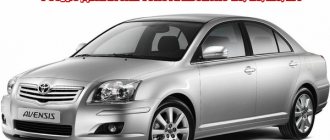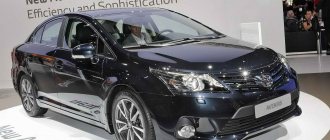Avensis and Camry are products of the same concern, but the philosophy of the cars is completely different. Avensis is a product of the European school, Camry is an American one. Hence all the pros and cons of cars.
Both cars have a difficult life path - from unquestioning worship in their homeland and the rapid conquest of other continents, to the loss of sales markets. The Camry business class sedan is especially popular in the USA and Asia, where factories were built specifically for it in Thailand, China, the Philippines, Malaysia and Taiwan. An equally talented representative of the “D” class, Avensis, has its fans in Europe and is produced only in Foggy Albion.
Unfortunately, in Russia the choice is limited: only Camry can be purchased from a car dealership; deliveries of Avensis stopped in 2012. But a large number of offers on the secondary market makes you wonder: Avensis or Camry, which is better.
Salon
Comparing the interior of cars, it is impossible to understand which is better than Camry or Avensis. Both cars have low seats, which does not have the best effect on comfort. In the Camry, the situation is saved by a wide center console, which gives the driver a feeling of freedom. Avensis chairs have better lateral support. Also in Avensis, the decorative inserts of the dashboard and doors look harmonious, unlike the pseudo-wood of the Camry.
Making a choice based on comparing Avensis or Camry in terms of rear seat roominess is unfair - the smaller Avensis loses. In it, three passengers in the back will not feel as comfortable as in the Camry, which has simply a huge amount of space in the back. And this is not surprising. For example, Avenis and Camry 2003 onwards. have a length of 4630 and 4815 mm, respectively.
Comfort
If we talk about the front seats of cars, then it’s impossible to say which is better. Both the Toyota Camry and Avensis are equipped with fairly low seats that support the shoulder blades of tall drivers. As a result, owners of Toyota sedans feel constrained on a long journey - because their shoulders are constantly tense, which in no way contributes to concentration on the road situation. In the Toyota Camry, a person feels more free thanks to the large central tunnel, but the Avensis holds the rider better in sharp turns due to the use of perforated leather upholstery. Plus, the silver-colored plastic trim on Toyota's smaller sedan fits in much better with the overall interior styling than the "faux wood" trim on the Camry.
The rear seat of the Toyota Camry can be safely called exemplary, since three adults can fit here at once, and they will not feel cramped. The Camry has so much legroom that two passengers can comfortably use laptops or large tablets without any discomfort. If you choose between buying a Camry or an Avensis, the compact sedan will lose in terms of rear space. Three adults will fit here, but they will constantly feel the elbows and shoulders of their neighbors, as well as rest against the backs of the front seats with their knees. Therefore, the Toyota Avensis is well suited for transporting children and teenagers in the rear seats, but not tall adults.
Options
If we compare the maximum configurations of the Avensis and Camry 2012, the conclusion arises that the smaller sedan is not inferior in its equipment. Even the basic list (Comfort) includes seven airbags, stabilization systems, and full power accessories, including heated seats. The only downside will be stamped wheels. The Prestige package is already equipped with a large color display of the multimedia system, air conditioning will replace climate control, and the wheels will become alloy. The top version (Elegance) includes keyless entry, a rear view camera, leather steering wheel, seats, power seats and steering wheel. The headlights in this version are xenon, and the navigation system is responsible for travel comfort.
In the minimum Comfort version, the Camry costs only 10% more than the Avensis, so the buyer has a logical choice of what to take: Avensis 2 or Camry v30. Moreover, the car is already equipped with rain sensors, alloy wheels, parking sensors, a leather steering wheel and climate control. The Elegance package pleases the driver with a rear view camera, leather upholstery and cruise control. The maximum configuration of the Camry, like the Avensis, includes keyless access, xenon, navigation and the same seventh airbag, which is installed in the base of the smaller sedan.
If we compare Avensis and Camry by body options, then preference is given to Avensis. It is available in a station wagon form factor, which is not in demand in the CIS countries, unlike in European countries. But having choice is always a plus.
Different variants
It is impossible to say that one car is better than another. The Toyota Camry wins over its spaciousness and comfort, as well as its wide list of basic equipment, although on some points the Avensis is not only not inferior to it, but even ahead. However, its disadvantages include mediocre handling, not very harmonious appearance, as well as weak dynamics and high fuel consumption. Also, Toyota Avensis is better suited for people who value the benefits of modern electronics and strive to achieve maximum safety. Therefore, the choice in this case remains a matter of personal preference for each person - for some, comfort and solidity are more important, while others will require good dynamics and high-quality multimedia.
Engines and gearboxes
If, without going into detail, we compare the passport characteristics of the Camry and the Avensis 2007, then it seems that in this regard the Camry is ahead of its opponent. But in practice, everything looks different - the accelerator pedal responds to pressure with a delay. The two and a half liter car comes to life only after 2-3 seconds, but this time can play a cruel joke when overtaking and maneuvering. The reason lies in the automatic transmission, which was borrowed from the Camry V6 3.5, so the power of this engine is not enough. The car is pleasant to drive outside the city, when sudden and frequent acceleration is not required.
Unlike the Camry, where only an automatic is available, the Avensis is equipped with a choice of manual or CVT. A properly tuned variator smoothly transmits torque to the wheels without noticeable drops in power and provides excellent dynamics. A sensitive gas pedal and a two-liter power unit accelerate the Avensis to “hundreds” one and a half seconds faster in comparison with the Camry, and the speedometer needle exceeds the mark of over 200 kilometers per hour.
If we compare the 2008 Avensis and the Camry 40 in terms of efficiency, then here too the Avensis is ahead - the fuel consumption of the smaller sedan is only 9 liters per 100 km, while a representative of the “business class” will need 11 liters to cover the same distance.
"Toyota Avensis"
"Toyota-Avensis"
"Toyota-Avensis"
Just a year ago, such a dilemma was impossible in principle: it is clear that there were few people willing to buy a smaller car of the same brand for a lot of money. Therefore, it is not surprising that in Russia the Avensis sold many times worse than the Camry. However, this year the market situation has changed, and now the choice between two Toyotas is no longer so speculative.
Ride quality
The moderately rigid suspension of the Avensis, tuned with high precision, determines high lateral stability and gives the driver the ability to maneuver at high speeds without the fear of losing course.
The Camry's suspension is the complete opposite of the Avensis - it is overly rolly and smooth, it does not allow the driver to take corners at high speed without risk. Even when driving on a straight road there is a feeling of “ruts”. But in the conditions of Russian roads, a soft suspension becomes an undeniable advantage - the shock absorbers easily absorb bumps, and in order to damage the car’s chassis you need to try hard.
Based on the driving characteristics, you can choose an Avensis or Camry based on your driving style.
Appearance
When you get acquainted with the exterior of cars, a lot immediately becomes clear. For example, in the appearance of the Superb, the traditional features of all cars produced by the company are visible, and the main emphasis is placed on solidity and representativeness. Camry looks like a “bandit” of the automotive world, as it is difficult not to notice aggression and relaxedness in the model’s appearance. It's safe to say that Superb and Camry are completely different in terms of appearance.
Of course, in the side and rear parts, you can find some similarities, but, basically, completely different design concepts were used when designing the exterior of the models.
Purely visually, a Japanese car looks more attractive.
Specifications
Two types of transmissions and three types of engines make the Avensis more variable in comparison with the Camry. The entry-level 1.6 engine (1ZR-FAE), despite its “small-displacement” volume, squeezes out 132 hp, but works only with a manual gearbox. Both the manual transmission and the continuously variable variator are also equipped with a 147-horsepower 1.8-liter engine (2ZR-FAE). And the oldest engine, the two-liter 3ZR-FAE, is equipped only with top versions, and only in conjunction with a CVT. Its power is 152 hp, and its high torque allows it to be used in various minivans of the Toyota concern.
Camry offers three engine options for its uncontested automatic. The smallest of them, the two-liter 1AZ-FE, has a power of 148 hp, which is comparable to the maximum Avensis engine. The most desirable for buyers is the 3.5 liter V-shaped six. The engine with the 2GR-FE index was derated to 249 hp especially for Russia. This was done to reduce transport taxes.
But the most popular in Russia is the 2AR-FE engine, which has a volume of 2.5 liters and a power of 181 hp. It’s worth thinking about buying a Camry with such an engine and in the XV50 body, because it has excellent characteristics:
- economical consumption - 7.8 l. 100 km in mixed mode
- ground clearance – 160 mm
- acceleration to 100 kilometers per hour – 9 seconds
- large volume of trunk and fuel tank - 506 and 70 liters, respectively.
Thanks to this and more, the car meets the requirements of car enthusiasts.
Toyota Avensis
This model does not have such a rich history as the Camry; production of the first generation began in 1997. T27 is a representative of the third, latest generation for today.
The car is equipped with a large number of different electronic systems , many of which are not available for other cars in this class. The presence of seven airbags, as well as a special device for protecting the driver’s knees, provides the highest level of safety compared to analogues.
Avensis is equipped with an email client, Bluetooth, and Internet access via a mobile device, that is, the level of comfort meets all modern standards and even exceeds them. The interior features perforated leather upholstery. From a design point of view, I would especially like to note the silver-colored plastic overlays.
The model has excellent dynamic characteristics. The 2-liter petrol engine, producing 152 horsepower , is capable of accelerating the car to 100 km/h in 10.3 seconds.
It can be noted that both acceleration and braking are carried out without any sudden jerks, and the gas pedal responds instantly to pressure.
Owner reviews
Alexander, 46 years old, Lipetsk
I am the owner of a 2008 Avensis, which I purchased at a car dealership. As of mid-2021, the mileage exceeded 250 thousand km. I was planning to buy a new car.
Among the tested cars was a Toyota Corolla sedan in the E210 body. The equipment is distinguished by an increased amount of electronics and additional devices that increase the level of driver comfort. But the quality of the interior materials is inferior to the Avensis. In addition, due to rising prices, the purchase had to be postponed.
Yaroslav, 32 years old, Kostroma
I was looking for a used class C car produced by Toyota, I examined several Avensis, but I was not satisfied with the technical condition of the cars.
I bought a 2010 Corolla E150 with a 1.6-liter engine and a manual transmission. After registration, he carried out a full maintenance including replacing the camshaft drive chain.
Toyota Camry
This model has a long history . The first generation, with the V10 index, entered the Japanese market back in 1982. The current generation XV50 is the seventh in a row and has been produced since 2011.
The style of the car has become closer to premium class standards. Initially, the model had some safety problems, since the seat belts did not work correctly in crash tests, and one of the wheels tried to get into the passenger compartment, but over time, engineers corrected these shortcomings, resulting in “Acceptable” ratings. ). You can also note the presence of a braking assistance system, multi-channel ABS and an electronic stabilization system.
The car has a very high level of comfort . There is both a light sensor and a rain sensor. There are heated mirrors and seats, automatic climate control, and in the middle configuration the model is equipped with a multimedia system and an eight-inch touch monitor. The presence of such a monitor allows the driver to assess the situation behind him through the image from the corresponding video camera. The seats are not very comfortable for tall drivers, as in many other Toyota models - let's attribute this to the peculiarities of the Japanese automobile industry.
The Camry is equipped with a 2.5-liter engine and a six-speed transmission . Despite the powerful engine ( 181 horsepower ), the car feels unsuitable for overtaking in the city and sudden acceleration. She feels much better on the highway in a quiet driving mode.
Equipment
Interestingly, the basic list of equipment for the Toyota Avensis includes seven airbags, which even includes a device that protects the driver’s knees. To become the owner of such luxury, the Camry owner will have to fork out for the most expensive equipment. But in the field of active safety, both cars are equal - both Avensis and Toyota Camry are equipped with multi-channel ABS, complemented by a braking assistance system and an electronic stabilization system. If we talk about comfort, Camry will have no equal in this area, because already in the “base” this mid-size sedan is equipped with automatic climate control, as well as rain and light sensors. If we compare Toyota Avensis and Camry, we can note that only the latter has a full power package in its base, including heated seats and mirrors, while the smaller sedan will require an additional payment even for rear windows.
Already in the average configuration of the Toyota Camry, the driver and front passenger can use a multimedia system with a large touch monitor (8 inches). It can display navigation maps or readings from a rear view camera, which makes it easier to drive a large Toyota sedan in urban environments. For Avensis, a similar system is also available, but you will have to take a closer look at the maximum configuration, which is priced quite expensive. But it has everything that a modern person needs who does not want to lag behind the latest technological advances:
- Bluetooth wireless connection;
- Ability to access the Internet via a mobile device;
- Clients for email, news reading and online browsing;
- Voice control;
- Possibility of calling using Hands Free.
Perhaps, the maximum configuration of the Toyota Avensis will be even more useful for the modern businessman than the Camry, which welcomes the traditional values.
Differences between Toyota Avensis and Toyota Camry
Let's start with car safety. Although both models have successfully passed crash tests and meet modern safety standards, the Avensis still appears to be a safer car. The designers clearly focused on this aspect in this car. Moreover, if in terms of active safety (ABS, braking assistance system) the cars are comparable, then in the matter of passive safety the Avensis has an advantage.
However, the Camry takes revenge in the area of comfort . The mere presence of a rear view camera, the image from which is displayed on the display in the cabin, gives it an undeniable advantage; there is no need to talk about heated seats. In comparison, even the rear windows on the Avensis will require you to pay extra. True, it is equipped with a large number of devices integrated with the Internet, but this is hardly really necessary for a modern driver.
Now let's look at the speed characteristics of the models. On the one hand, the Camry has a more powerful engine with a larger displacement, but this does not give it a speed advantage over its rival. The point is precisely in its large dimensions and, accordingly, greater mass. The smaller sedan accelerates to 60 mph 1.5 seconds faster than its larger-volume rival. Also, the Avensis reacts almost instantly to pressing the gas pedal, while the Camry has a second delay. At the same time, due to its large size, its average fuel consumption is higher - 11 liters per 100 km versus 9 .
Cars behave differently on different surfaces. On good asphalt, the Avensis seems perfect, but the Camry's suspension seems overly soft. But the situation changes if you drive onto a country road. Here the seventh generation model demonstrates its ability to ignore large potholes at high speed.
Check on the go
Power units
It would seem that the advantages of the Toyota Camry are obvious: a powerful 2.5-liter engine, a six-speed classic automatic transmission with a modern electronic unit and only 70 extra kilograms compared to the Avensis. However, in practice, everything turns out to be not so rosy - immediately after pressing the gas pedal, the Camry stops, as if it needs another second to comprehend the task and only then slowly starts. According to subjective sensations, the acceleration of the Toyota Camry becomes violent and dynamic only 2-3 seconds after the command is given. During this time, the moment for a successful maneuver may be missed, which will not only be annoying, but also quite dangerous.
The Camry's six-speed automatic transmission is to blame, which differs from the gearbox installed on the modification with a more powerful 3.5 engine only in different gear ratios. A four-cylinder engine is clearly not enough for it, which is where severe delays arise. Therefore, the Toyota Camry can be called optimal for measured driving on the highway, but not for sudden acceleration and overtaking in the city.
So what should you choose?
The choice of car, as always, will be determined by the needs that you have. Let’s say right away that the cars are almost the same in price. Camry has more spaciousness and high comfort for the driver and passengers.
Also, the design of the car looks more solid. Avensis is smaller in size, but has better speed characteristics, improved handling and at the same time it is more economical. It is impossible not to note the level of safety, which is higher in the smaller sedan.
Many buyers do not pay due attention to this, subconsciously hoping never to get into an accident in their life, but in vain, because even with your ideal driving, your safety also depends on other drivers, and you never know what to expect from them. Finally, the Avensis is equipped with modern electronic devices, which can also make a difference for the driver.
Good day everyone!
What do you think about this alternative? Let’s assume the budget is around 500 thousand, for this money you can get a Camry 30 or a second Avensis sedan, both from about 2004, we are considering a 3.0 engine for the Camry and a 2.4 for the Avensis.
So, we have the same year, the same price, the dynamic characteristics (judging by the rated acceleration to 100) are approximately the same, and finally the same “Toyota” nameplate =). What advantages do I see of one and the other option:
Camry: + Larger, more solid + More spacious + 3 liters + For my taste, prettier in appearance
Avensis: + Newer model -> perhaps more technologically advanced + 5-speed automatic + According to the passport, consumption is lower + Tax is lower + The interior is more visually interesting
But it’s not clear how much more spacious the Camry’s interior is; how much weaker is 2.4 and what is its real consumption; what about automatic transmissions: it is clear that 5 steps are better than 4, but what about reliability, smooth shifting; what about the factory noise and interior trim materials...
In general, please share your thoughts on the topic.
Conclusion
It is impossible to say unequivocally which is better than Avensis or Camry. Avensis is suitable for dynamic people who value the safety and appearance of a car. Camry is created for connoisseurs of comfort and fundamentals. The choice is yours.











